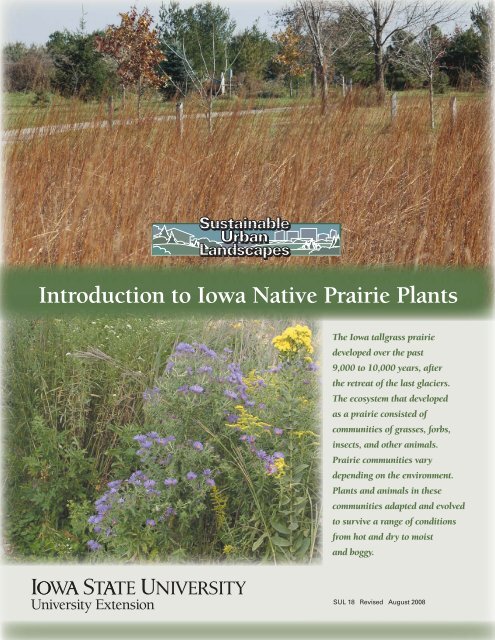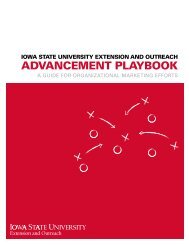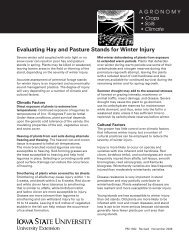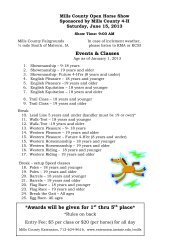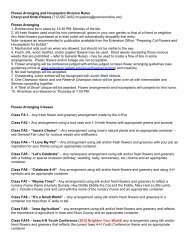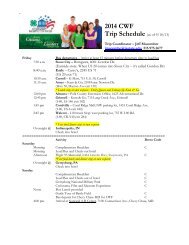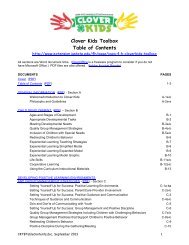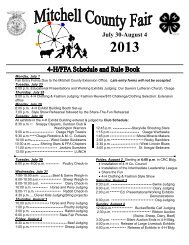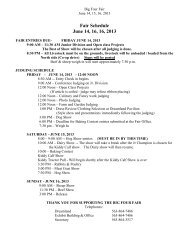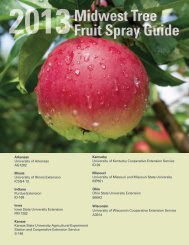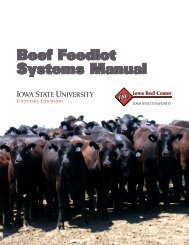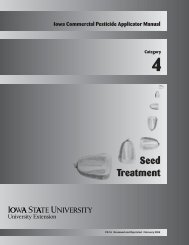Introduction to Iowa Native Prairie Plants - Iowa State University ...
Introduction to Iowa Native Prairie Plants - Iowa State University ...
Introduction to Iowa Native Prairie Plants - Iowa State University ...
Create successful ePaper yourself
Turn your PDF publications into a flip-book with our unique Google optimized e-Paper software.
<strong>Introduction</strong> <strong>to</strong> <strong>Iowa</strong> <strong>Native</strong> <strong>Prairie</strong> <strong>Plants</strong><br />
The <strong>Iowa</strong> tallgrass prairie<br />
developed over the past<br />
9,000 <strong>to</strong> 10,000 years, after<br />
the retreat of the last glaciers.<br />
The ecosystem that developed<br />
as a prairie consisted of<br />
communities of grasses, forbs,<br />
insects, and other animals.<br />
<strong>Prairie</strong> communities vary<br />
depending on the environment.<br />
<strong>Plants</strong> and animals in these<br />
communities adapted and evolved<br />
<strong>to</strong> survive a range of conditions<br />
from hot and dry <strong>to</strong> moist<br />
and boggy.<br />
SUL 18 Revised August 2008<br />
<strong>Introduction</strong> IInt<br />
nt ntro rodu du duct ct ctio io ion n <strong>to</strong> <strong>to</strong> Iow I <strong>Iowa</strong> ow owa a Na Nati <strong>Native</strong> ti tive ve Pra P<strong>Prairie</strong><br />
<strong>Prairie</strong> rair ir i ie PPla<br />
<strong>Plants</strong> la lant nt nts 1
TRAER, TAMA COUNTY, IOWA<br />
<strong>Introduction</strong> <strong>to</strong><br />
<strong>Iowa</strong> <strong>Native</strong> <strong>Prairie</strong> <strong>Plants</strong><br />
This publication focuses on the<br />
native plants that inhabit prairie<br />
communities. “<strong>Native</strong> plants” are<br />
plants that were growing naturally<br />
in a particular area before human<br />
settlement. Although many native<br />
plants are “prairie plants,” the focus<br />
herein is on growing individual<br />
species or combinations of species<br />
in a garden or large planting,<br />
rather than on prairie construction<br />
or res<strong>to</strong>ration.<br />
<strong>Prairie</strong>s are complex ecosystems<br />
that blend the <strong>to</strong>pography and soils<br />
of an area with plant and animal<br />
communities that can live <strong>to</strong>gether<br />
in a stable relationship. The process<br />
can be complex and requires time<br />
and patience. Also, it is diffi cult <strong>to</strong><br />
develop a prairie ecosystem on a<br />
space less than about a quarter acre.<br />
Most people, however, choose <strong>to</strong><br />
create a natural-looking garden or<br />
planting that serves many of the<br />
same functions as a prairie, namely,<br />
2 <strong>Introduction</strong> <strong>to</strong> <strong>Iowa</strong> <strong>Native</strong> <strong>Prairie</strong> <strong>Plants</strong><br />
beauty, weed management, wildlife<br />
habitat, and the reduction of soil<br />
erosion and runoff. When planning<br />
a garden of native plants, it is a good<br />
idea <strong>to</strong> visit other gardens that have<br />
native plantings or <strong>to</strong> visit public<br />
gardens <strong>to</strong> see the size, form, and<br />
spread of the plants you would like<br />
<strong>to</strong> grow. Local prairie enthusiasts<br />
or conservationists organize prairie<br />
walks that can be a source of specifi c<br />
information about prairies. A visit <strong>to</strong><br />
a prairie enables you <strong>to</strong> see different<br />
plants in their natural setting.<br />
There are many advantages <strong>to</strong><br />
growing native plants:<br />
<strong>Native</strong> plants are well adapted <strong>to</strong><br />
local conditions. They are vigorous<br />
and hardy, so they can survive winter<br />
cold, and summer heat, drought and<br />
windy conditions.<br />
Once established, they require<br />
little or no irrigation. No fertilization<br />
is needed.<br />
TRAER, TAMA COUNTY, IOWA<br />
An established urban reconstructed prairie<br />
They are resistant or <strong>to</strong>lerant <strong>to</strong><br />
most insect pests and diseases.<br />
A blend of native species provides<br />
season-long color and interest.<br />
<strong>Native</strong> species are members of<br />
a plant and animal community<br />
that balances itself when there is a<br />
diverse assemblage of species. This<br />
natural balance keeps native plants<br />
from becoming invasive.<br />
They attract butterfl ies by serving<br />
as host plants for caterpillars and<br />
nectar plants for butterfl ies.<br />
Growing native plants is a fun<br />
learning process. Each season brings<br />
some answers and more questions.<br />
A partial guide for native plants that<br />
may be suitable for your landscape<br />
can be found on pages 3–6. Note the<br />
column listing plant height. Some<br />
of the tall natives are not suitable<br />
for small spaces without staking<br />
individual plants.
<strong>Iowa</strong> <strong>Native</strong> <strong>Prairie</strong> <strong>Plants</strong>—Pic<strong>to</strong>rial Guide<br />
Rattlesnake master<br />
Eryngium yuccafolium<br />
Butterfl y milkweed<br />
Asclepias tuberosa<br />
Coreopsis<br />
Coreopsis palmata<br />
Spiderwort<br />
Tradescantia ohioensis<br />
Swamp milkweed<br />
Asclepias incarnata<br />
Partridge pea<br />
Chamaecrista fasciculata<br />
Purple prairie clover<br />
Dalea purpurea<br />
Purple conefl ower<br />
Echinacea purpurea<br />
Great blue lobelia and goldenrod<br />
Lobelia syphilitica, Solidago sp.<br />
<strong>Introduction</strong> <strong>Introduction</strong> <strong>to</strong> <strong>Iowa</strong> <strong>Native</strong> <strong>Prairie</strong> <strong>Plants</strong> 3<br />
3
<strong>Iowa</strong> <strong>Native</strong> <strong>Prairie</strong> <strong>Plants</strong><br />
Grasses<br />
Soil Moisture Mature Flower<br />
Common/Latin Name Conditions* Height Period Comments<br />
Big bluestem M 5–7’ Aug.–Sept. Sometimes known as “turkey foot” by the pioneers. Dominant plant of the eastern tallgrass prairie. Warm-season grass.<br />
Andropogon gerardi<br />
Indiangrass M 3–6’ Aug.–Sept. The plant forms an attractive mounded clump; excellent specimen plant in perennial gardens; warm-season grass.<br />
Sorghastrum nutans<br />
Switchgrass M 3–6’ July–Aug. Bright yellow <strong>to</strong> tan fall color; seed heads are wispy sprays; warm-season grass.<br />
Panicum virgatum<br />
Little bluestem DM 2–3’ Aug.–Sept. Red-brown and russet fall color; specimen plant in perennial gardens; warm-season grass.<br />
Schizachyrium scoparium<br />
Canada wildrye M 2–3’ May–June Distinctive wheat-looking seed head that provides texture <strong>to</strong> mixed plantings; cool-season grass.<br />
Elymus canadensis<br />
Sideoats grama M 8–18’ Apr.–June Establishes quickly from seed; cool-season grass.<br />
Bouteloua curtipendula<br />
<strong>Prairie</strong> dropseed M/DM 2–3’ August Beautiful grass for variation in texture and form; warm-season grass.<br />
Sporobolus heterolepis<br />
4 <strong>Introduction</strong> <strong>to</strong> <strong>Iowa</strong> <strong>Native</strong> <strong>Prairie</strong> <strong>Plants</strong><br />
Forbs<br />
Butterfl y milkweed M 2–3’ June–Aug. Orange <strong>to</strong> yellow fl owers; attracts many butterfl ies; host plant for monarch butterfl ies.<br />
Asclepias tuberosa<br />
Swamp milkweed W 3–5’ June–Aug. Pale pink <strong>to</strong> rose colored; smaller and more compact than common milkweed; host plant for monarch butterfl ies.<br />
Asclepias incarnata<br />
Partridge pea M 1–2’ July–Aug. A showy, annual legume that has bright yellow fl owers and dark green foliage.<br />
Chamaecrista fasciculata<br />
Cardinal fl ower W 2–3’ Aug.–Sept. Spike of red fl owers; requires wet sites; does best along stream edges.<br />
Lobelia cardinalis<br />
Great blue lobelia WM/W 2–3’ Aug.–Sept. Medium blue fl owers. More common in natural <strong>Iowa</strong> habitats than cardinal fl ower.<br />
Lobelia syphilitica<br />
New England aster M 2–4’ Sept.–Oct. Purple or pink. Makes attractive cut fl ower in the fall; attracts butterfl ies and moths.<br />
Aster novae-angliae<br />
Plains tickseed DM 1–3’ May–Aug. Yellow fl owers. After fl owering, the disc turns brown and produces seeds that resemble ticks, hence its common name.<br />
Coreopsis tinc<strong>to</strong>ria Tickseed is a good nectar source for bees and a valuable plant in the prairie biome.<br />
<strong>Prairie</strong> coreopsis<br />
Coreopsis palmata<br />
Pale purple conefl ower M 2–3’ June–July Long-lived perennial; resembles daisies with backward, curving pink-purple ray fl owers; the fl ower center contains a prickly<br />
Echinacea pallida raised dome.<br />
Purple conefl ower M 2–3’ July–Aug. A native <strong>to</strong> far southeast <strong>Iowa</strong>; grown extensively in home gardens.<br />
Echinacea purpurea<br />
Bottle gentian M 1–2’ Aug.–Oct. The common name notes that its fl owers stay closed when it is blooming. Flowers are vibrant indigo-purple.<br />
Gentiana andrewsii<br />
<strong>Prairie</strong> smoke M/D 1–2’ May–June Delicate reddish-pink blooms in spring give way <strong>to</strong> fl uffy seed heads that look like puffs of smoke in summer. <strong>Native</strong> <strong>to</strong> extreme<br />
Geum trifolium northeast <strong>Iowa</strong>.
False sunfl ower or Oxeye M/WM 3–5’ July–Sept. Smaller than most sunfl owers; perennial; has interesting opposite-leaved foliage with 1-inch yellow fl ower heads from<br />
Heliopsis helianthoides midsummer on; can be somewhat aggressive.<br />
<strong>Prairie</strong> blazing star or M 1–4’ July–Oct. The corms served as winter food for early settlers (and rodents). This signature tallgrass prairie plant has gained fame as a<br />
<strong>Prairie</strong> gayfeather lavender cut fl ower in the fl orist industry. Pycnostachya means “thick-spiked,” referring <strong>to</strong> the densely packed fl ower spikes.<br />
Liatris pycnostachya<br />
Rough blazing star or M/DM 2–3’ July–Oct. Violet/purple fl owers. The fl ower spikes are larger and more separated along the stem than those of prairie blazing star.<br />
Rough gayfeather It takes longer <strong>to</strong> establish than its cousin, prairie blazing star.<br />
Liatris aspera<br />
Leadplant DM 1–3’ June–Aug. Small purple fl owers; grayish-white compound foliage on perennial stems.<br />
Amorpha canescens<br />
Shooting star M/DM 1–2’ May Will <strong>to</strong>lerate some shade; native <strong>to</strong> eastern <strong>Iowa</strong>. Quite showy in the early season with pale pink <strong>to</strong> white dramatic fl owers.<br />
Dodecatheon meadia<br />
Golden Alexander WM/M 1–3’ Apr.–June Perennial of moist woods, prairie meadows, and thickets; establishes quickly from seed; yellow umbel resembling a more delicate<br />
Zizia aurea Queen Anne’s lace.<br />
Wild bergamot M 1–3’ July–Aug. Lavender blooms; like all members of the mint family, it has square stems and is pleasantly fragrant.<br />
Monarda fi stulosa<br />
Gray-headed conefl ower M 3–4’ June–Sept. Yellow fl owers. When crushed, the mature head emits an anise fragrance. Easy <strong>to</strong> establish and showy.<br />
or Yellow conefl ower Both gray-headed conefl ower and black-eyed Susan are great additions <strong>to</strong> mass plantings because they establish quickly,<br />
Ratibida pinnata bloom prominently, and in a few years are replaced by other species as the planting becomes permanent.<br />
Black-eyed Susan M 1–2’ June–Oct. Gold fl owers. Black-eyed Susan is a great addition <strong>to</strong> mass plantings because it establishes quickly, blooms prominently, and then<br />
Rudbeckia hirta in a few years is replaced by other species as the planting becomes permanent. Its life cycle ranges from a sturdy annual <strong>to</strong> biennial.<br />
Canada goldenrod M 3–5’ July–Sept. Common; easy <strong>to</strong> establish and provides rich golden fall color. Traditionally, and because it is so showy, it is falsely accused of<br />
Solidago canadensis and causing human hay fever. (Its pollen is not windborne.)<br />
Gray goldenrod<br />
Solidago nemoralis<br />
Stiff goldenrod M 2–4’ Aug.–Oct. Yellow fl owers. The fl owers of this species are in a prominent fl at-<strong>to</strong>pped cluster. Before fl owering, the plant is erect and subtly<br />
Solidago rigida attractive, with downy hair on the leaves.<br />
Spiderwort M/WM 1–2’ Apr.–July The plant’s form and rich violet fl owers are a hidden treat in the prairie planting.<br />
Tradescantia ohioensis<br />
Compass plant M 4–10’ Aug.–Sept. Yellow, daisy-like fl owers; one of the signature plants of the <strong>Iowa</strong> prairie. Early travelers used the plant’s habit of orienting<br />
Silphium laciniatum its deeply divided, side-turned leaves due north and south, making it a natural compass.<br />
Purple prairie clover M 1–2’ June–Aug. 1–3’’ terminal spikes of rose- <strong>to</strong> magenta-colored fl owers that open from the <strong>to</strong>p down. It establishes easily from seed, and will<br />
Dalea purpurea often fl ower the same season it is planted. Good addition for most urban and non-urban settings.<br />
White prairie clover M/DM 1–3’ June–Aug. Similar <strong>to</strong> purple prairie clover, but the white fl owers and the divided leaves are larger. It is slower <strong>to</strong> establish and does not<br />
Dalea candida compete very well, especially in wet soil conditions.<br />
Round-headed bushclover M/DM 2–4’ July–Aug. Common in most <strong>Iowa</strong> prairies; has silvery green trefoil leaves and clusters of white fl owers that turn chocolate brown<br />
Lespedeza capitata as they mature.<br />
Wild petunia M 8’’–1’ June–Aug. A savannah or woodland-edge plant that has light lavender 1 <strong>to</strong> 1.5’’ fl owers on low-growing, dark green plants.<br />
Ruellia humilis<br />
Rattlesnake master M/DM 2–4’ July–Aug. Adds texture and variety <strong>to</strong> a prairie; yucca-like leaves have soft spiny edges. Years ago it was sometimes considered a remedy<br />
Eryngium yuccafolium for snakebite. (Don’t try that at home.)<br />
*W = Wet WM = Wet Mesic M = Mesic DM = Dry Mesic D = Dry<br />
<strong>Introduction</strong> <strong>to</strong> <strong>Iowa</strong> <strong>Native</strong> <strong>Prairie</strong> <strong>Plants</strong> 5
<strong>Iowa</strong> <strong>Native</strong> <strong>Prairie</strong> <strong>Plants</strong>—Pic<strong>to</strong>rial Guide<br />
Canada wildrye<br />
Elymus canadensis<br />
Sideoats grama<br />
Bouteloua curtipendula<br />
Rough blazing star<br />
Liatris aspera<br />
6 66 <strong>Introduction</strong> <strong>to</strong> <strong>to</strong> <strong>Iowa</strong> <strong>Iowa</strong> <strong>Native</strong> <strong>Native</strong> <strong>Prairie</strong> <strong>Prairie</strong> <strong>Plants</strong><br />
<strong>Plants</strong><br />
Little bluestem<br />
Schizachyrium scoparium<br />
<strong>Prairie</strong> blazing star<br />
Liatris pycnostachya<br />
Cardinal fl ower<br />
Lobelia cardinalis<br />
Indiangrass<br />
Sorghastrum nutans<br />
Gray-headed conefl ower and wild bergamot<br />
Ratibida pinnata, Monarda fi stulosa (pink)<br />
Compass plant<br />
Silphium laciniatum
Big bluestem (Andropogon gerardii)—<br />
MESIC, height 5–7 ft. It begins growth<br />
in late spring and fl owers in late summer.<br />
This tall, deep-rooted perennial<br />
was the primary grass of the eastern<br />
tallgrass prairie that once covered<br />
thousands of acres. The seed head<br />
is three-branched, resulting in its<br />
common name—“turkey foot.”<br />
Many native plants have been<br />
selectively bred, or even hybridized<br />
so that they meet the needs of<br />
people. An example is prairie blazing<br />
star, Liatris pycnostachya. Varieties<br />
of blazing star have been selected<br />
from nature for their form, fl ower<br />
color, and durability so they fi t both<br />
landscape needs of homeowners and<br />
cut fl ower needs of fl orists.<br />
Planting non-local strains near<br />
a prairie remnant or a native<br />
reconstruction should be avoided<br />
because of the potential for genetic<br />
contamination. If you are looking<br />
for plants that are native <strong>to</strong> your<br />
particular area, you need <strong>to</strong> fi nd a<br />
commercial seed or plant source that<br />
is from local ecotypes. Many suggest<br />
using seed sources from within<br />
approximately a 50-mile radius<br />
Wild bergamot (Monarda fi stulosa)—<br />
MESIC, height 1–3 ft. This perennial<br />
prairie forb blooms between June<br />
and August. Its rosy-lavendercolored<br />
fl owers are attractive <strong>to</strong><br />
bees and butterfl ies.<br />
of your planting. When ordering<br />
or purchasing seed, check with<br />
an expert regarding the optimum<br />
seeding rate.<br />
Note: So called “wildfl ower” mixes<br />
may contain few native wildfl ower<br />
seeds and may contain many plants<br />
native <strong>to</strong> the United <strong>State</strong>s but not<br />
<strong>to</strong> <strong>Iowa</strong>.<br />
Local Ecotypes<br />
<strong>Plants</strong> of the same species will<br />
vary considerably, depending<br />
on their geographic origin.<br />
Just as people have different<br />
traits that give them different<br />
attributes such as height, hair<br />
color, and facial shape, each<br />
plant species has a range of<br />
genetic variability.<br />
For more information<br />
Check these additional titles in the<br />
series on prairies and native plants<br />
at www.extension.iastate.edu/s<strong>to</strong>re.<br />
<strong>Prairie</strong>s and <strong>Native</strong> Plantings as<br />
Outdoor Classrooms, SUL 19<br />
References and Resources for <strong>Prairie</strong>s<br />
and <strong>Native</strong> Plantings, SUL 20<br />
Grasses versus Forbs<br />
Grasses typically have long leaves<br />
with parallel veins and can be useful<br />
in adding dimension <strong>to</strong> a planting.<br />
Several of the tall grasses wave gently<br />
in the wind, and they can provide a<br />
dash of subtle fall and winter color.<br />
Grasses do have fl owers, which are<br />
generally greenish, yet some have<br />
interesting fl owering structures<br />
that add appeal <strong>to</strong> the planting.<br />
Some grasses, such as Indiangrass,<br />
are well suited as stand-alone or<br />
clumps of accent plants, whereas<br />
others are better suited for fi lling<br />
in group plantings.<br />
Forbs are the broadleaved plants<br />
in a prairie and often have showy<br />
blooms. Forbs may add color,<br />
texture, habitat for wildlife, and<br />
even scent <strong>to</strong> the planting.<br />
The choice between separate<br />
plantings and mixed plantings<br />
of forbs and grasses is situationdependent.<br />
Gardeners should<br />
consider the intended use of the site.<br />
Mixed plantings generally require<br />
more space and an understanding<br />
of the differences in biology of the<br />
plants being used.<br />
Funding support for this publication provided by Living Roadway Trust Fund, <strong>Iowa</strong> Department of Transportation.<br />
<strong>Introduction</strong> <strong>to</strong> <strong>Iowa</strong> <strong>Native</strong> <strong>Prairie</strong> <strong>Plants</strong> 7
Environments<br />
for <strong>Native</strong> <strong>Plants</strong><br />
Dry soils are found on well <strong>to</strong><br />
excessively drained, usually exposed<br />
sites. Soils that are thin <strong>to</strong> bedrock,<br />
or are sandy or gravelly and that<br />
occur on steep areas are typical. Dry<br />
sites are more common on southfacing<br />
slopes where it is the warmest<br />
and driest during the summer.<br />
Characteristics of the plants adapted<br />
<strong>to</strong> these areas include the following:<br />
<strong>Plants</strong> often less than 3 feet in<br />
height<br />
Leaves that are adapted <strong>to</strong><br />
conserve moisture (thick surfaces,<br />
wilt throughout the day, or other<br />
actions <strong>to</strong> avoid water loss)<br />
ISU FEEL RECONSTRUCTED PRAIRIE, BOONE COUNTY, IOWA<br />
8 <strong>Introduction</strong> <strong>to</strong> <strong>Iowa</strong> <strong>Native</strong> <strong>Prairie</strong> <strong>Plants</strong><br />
Mesic refers <strong>to</strong> sites that have good<br />
drainage, ample seasonally available<br />
water, and deep soils. A good<br />
description of mesic is moist, yet<br />
well drained. The subsoil (below<br />
the dark <strong>to</strong>psoil) is brightly colored,<br />
which indicates good drainage.<br />
Wet sites have seasonally high<br />
water tables and often occur low<br />
on the landscape. Sedges (grasslike<br />
plants with triangular stems in<br />
cross section) may be a prominent<br />
group of species in wet sites, and<br />
the <strong>to</strong>psoil is either coal black <strong>to</strong><br />
several feet in depth, or the subsoil is<br />
noticeably dull gray colored, or both.<br />
Pale Purple Conefl ower (Echinacea pallida)—MESIC, height 2–3 ft. Flowers<br />
bloom in June and July. These long-lived perennials resemble daisies, but with<br />
backward-curving pink-purple ray fl owers; the fl ower center contains a prickly<br />
raised dome.<br />
<strong>Introduction</strong> <strong>to</strong> <strong>Iowa</strong> <strong>Native</strong> <strong>Prairie</strong> <strong>Plants</strong> was originally printed as PM 1956.<br />
Seed and plant collection ethics<br />
Existing populations of native<br />
plants need protection. Some<br />
human-assisted seed dispersal<br />
(harvested seed) is often<br />
acceptable without the existing<br />
population being damaged,<br />
but some seed needs <strong>to</strong> remain<br />
<strong>to</strong> renew the native stand.<br />
ALWAYS get permission from<br />
the managers of a native site<br />
before harvesting seed, and<br />
limit yourself <strong>to</strong> taking no<br />
more than one-third of the seed<br />
crop produced. Taking actual<br />
plants <strong>to</strong> transplant <strong>to</strong> another<br />
area is not acceptable, unless<br />
construction or other activities<br />
on the site will cause the<br />
vegetation <strong>to</strong> be destroyed.<br />
Also, some native plants may<br />
not survive transplanting.<br />
Look for local information and<br />
assistance before you engage in<br />
collecting forays.<br />
Prepared by Rich Pope and Linda Naeve, extension<br />
specialists, and Joyce Hornstein, former extension<br />
specialist, Department of En<strong>to</strong>mology. Pho<strong>to</strong>s by<br />
Rich Pope, Joyce Hornstein, Keven Arrowsmith,<br />
and Linda Naeve, <strong>Iowa</strong> <strong>State</strong> <strong>University</strong> Extension,<br />
and Steve Holland, <strong>Iowa</strong> Department of Transportation.<br />
Edited by Julie Todd, former extension specialist,<br />
Department of En<strong>to</strong>mology, and designed by<br />
Donna Halloum, Information Technology Services.<br />
Special thanks <strong>to</strong> content reviewers Dan Rockwell,<br />
Dick Faas, Inger Lamb, Jean Eels, and Carl Kurtz.<br />
File: Horticulture 2-10<br />
. . . and justice for all<br />
The U.S. Department of Agriculture (USDA)<br />
prohibits discrimination in all its programs and<br />
activities on the basis of race, color, national origin,<br />
gender, religion, age, disability, political beliefs,<br />
sexual orientation, and marital or family status.<br />
(Not all prohibited bases apply <strong>to</strong> all programs.)<br />
Many materials can be made available in alternative<br />
formats for ADA clients. To fi le a complaint<br />
of discrimination, write USDA, Offi ce of Civil<br />
Rights, Room 326-W, Whitten Building, 14th<br />
and Independence Avenue, SW, Washing<strong>to</strong>n, DC<br />
20250-9410 or call 202-720-5964.<br />
Issued in furtherance of Cooperative Extension<br />
work, Acts of May 8 and June 30, 1914, in cooperation<br />
with the U.S. Department of Agriculture.<br />
Jack M. Payne, direc<strong>to</strong>r, Cooperative Extension<br />
Service, <strong>Iowa</strong> <strong>State</strong> <strong>University</strong> of Science and<br />
Technology, Ames, <strong>Iowa</strong>.


